transmission oil YAMAHA YZ125LC 2013 Owners Manual
[x] Cancel search | Manufacturer: YAMAHA, Model Year: 2013, Model line: YZ125LC, Model: YAMAHA YZ125LC 2013Pages: 168, PDF Size: 8.19 MB
Page 8 of 168
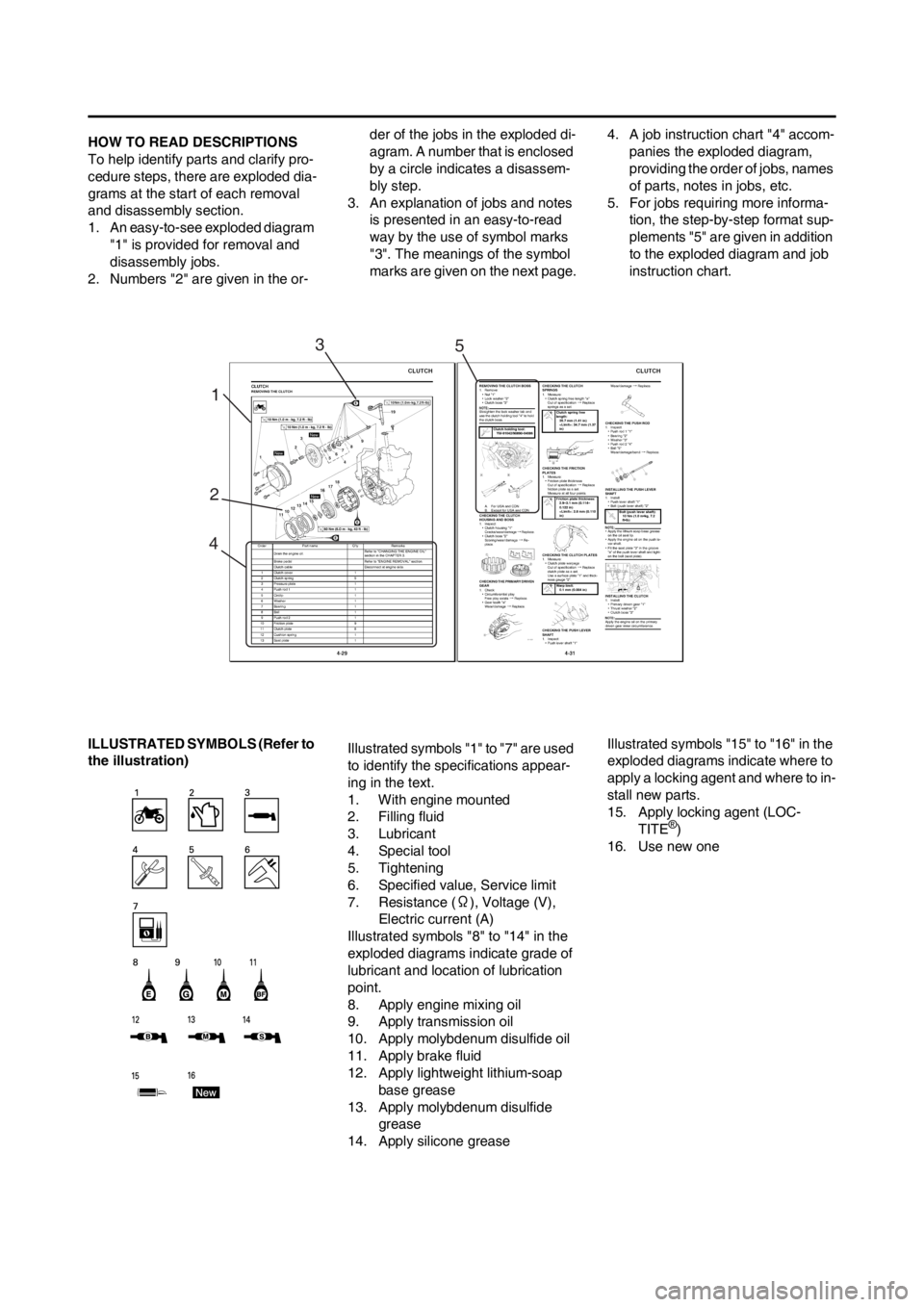
HOW TO READ DESCRIPTIONS
To help identify parts and clarify pro-
cedure steps, there are exploded dia-
grams at the start of each removal
and disassembly section.
1. An easy-to-see exploded diagram
"1" is provided for removal and
disassembly jobs.
2. Numbers "2" are given in the or-der of the jobs in the exploded di-
agram. A number that is enclosed
by a circle indicates a disassem-
bly step.
3. An explanation of jobs and notes
is presented in an easy-to-read
way by the use of symbol marks
"3". The meanings of the symbol
marks are given on the next page.4. A job instruction chart "4" accom-
panies the exploded diagram,
providing the order of jobs, names
of parts, notes in jobs, etc.
5. For jobs requiring more informa-
tion, the step-by-step format sup-
plements "5" are given in addition
to the exploded diagram and job
instruction chart.
ILLUSTRATED SYMBOLS (Refer to
the illustration)Illustrated symbols "1" to "7" are used
to identify the specifications appear-
ing in the text.
1. With engine mounted
2. Filling fluid
3. Lubricant
4. Special tool
5. Tightening
6. Specified value, Service limit
7. Resistance (Ω), Voltage (V),
Electric current (A)
Illustrated symbols "8" to "14" in the
exploded diagrams indicate grade of
lubricant and location of lubrication
point.
8. Apply engine mixing oil
9. Apply transmission oil
10. Apply molybdenum disulfide oil
11. Apply brake fluid
12. Apply lightweight lithium-soap
base grease
13. Apply molybdenum disulfide
grease
14. Apply silicone greaseIllustrated symbols "15" to "16" in the
exploded diagrams indicate where to
apply a locking agent and where to in-
stall new parts.
15. Apply locking agent (LOC-
TITE
®)
16. Use new one
1
23
45
Page 15 of 168
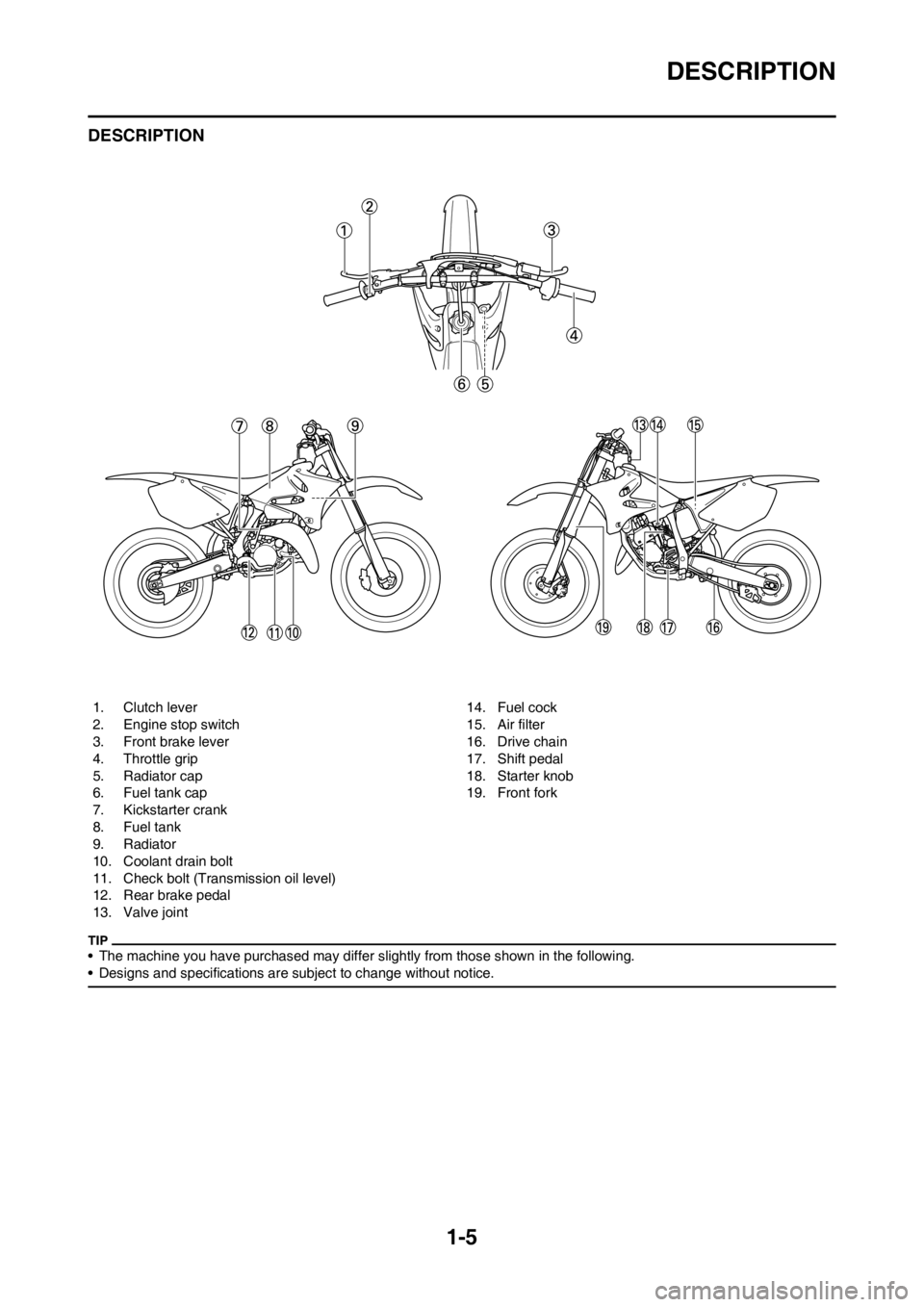
1-5
DESCRIPTION
DESCRIPTION
• The machine you have purchased may differ slightly from those shown in the following.
• Designs and specifications are subject to change without notice.
1. Clutch lever
2. Engine stop switch
3. Front brake lever
4. Throttle grip
5. Radiator cap
6. Fuel tank cap
7. Kickstarter crank
8. Fuel tank
9. Radiator
10. Coolant drain bolt
11. Check bolt (Transmission oil level)
12. Rear brake pedal
13. Valve joint14. Fuel cock
15. Air filter
16. Drive chain
17. Shift pedal
18. Starter knob
19. Front fork
Page 22 of 168
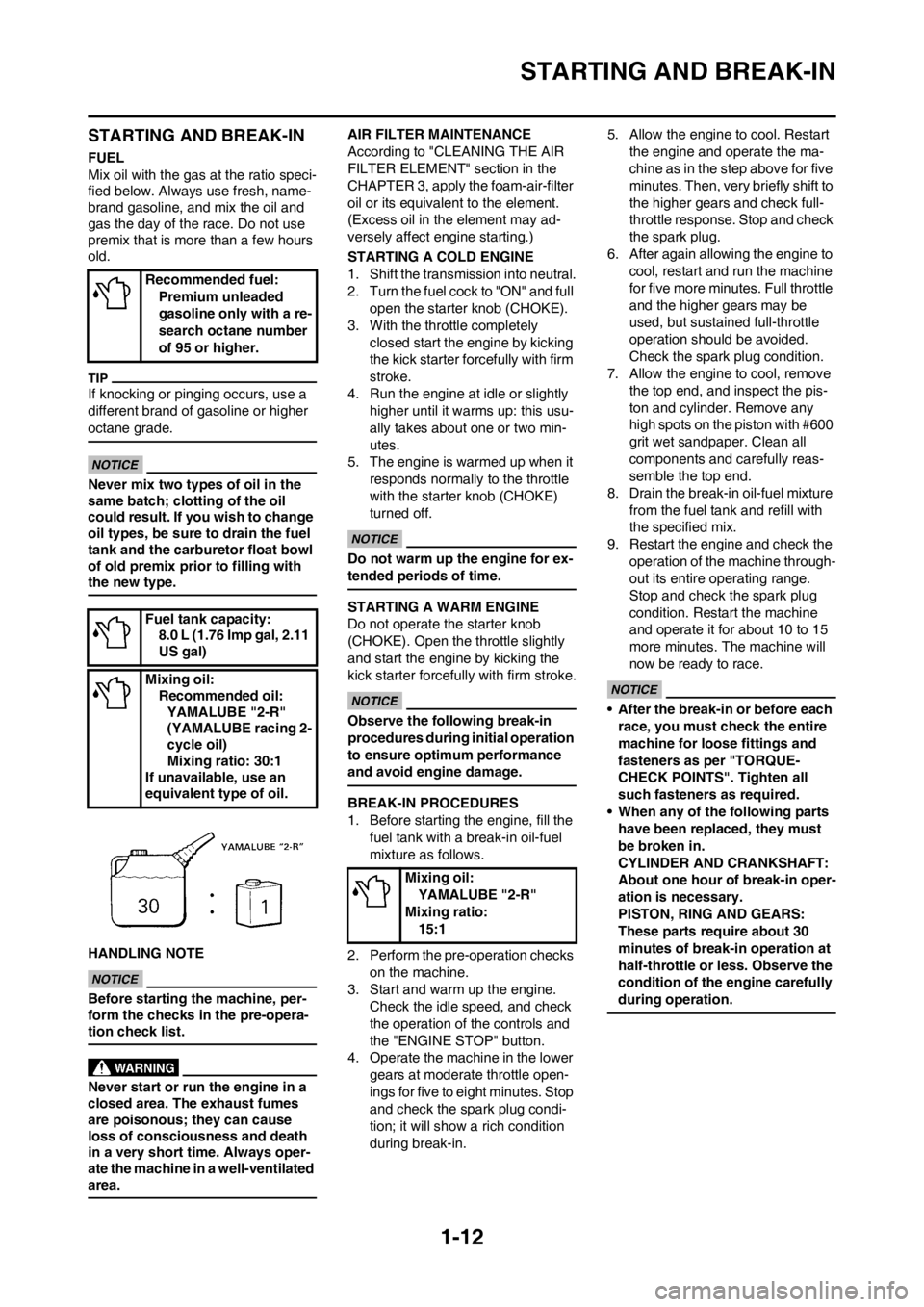
1-12
STARTING AND BREAK-IN
STARTING AND BREAK-IN
FUEL
Mix oil with the gas at the ratio speci-
fied below. Always use fresh, name-
brand gasoline, and mix the oil and
gas the day of the race. Do not use
premix that is more than a few hours
old.
If knocking or pinging occurs, use a
different brand of gasoline or higher
octane grade.
Never mix two types of oil in the
same batch; clotting of the oil
could result. If you wish to change
oil types, be sure to drain the fuel
tank and the carburetor float bowl
of old premix prior to filling with
the new type.
HANDLING NOTE
Before starting the machine, per-
form the checks in the pre-opera-
tion check list.
Never start or run the engine in a
closed area. The exhaust fumes
are poisonous; they can cause
loss of consciousness and death
in a very short time. Always oper-
ate the machine in a well-ventilated
area.
AIR FILTER MAINTENANCE
According to "CLEANING THE AIR
FILTER ELEMENT" section in the
CHAPTER 3, apply the foam-air-filter
oil or its equivalent to the element.
(Excess oil in the element may ad-
versely affect engine starting.)
STARTING A COLD ENGINE
1. Shift the transmission into neutral.
2. Turn the fuel cock to "ON" and full
open the starter knob (CHOKE).
3. With the throttle completely
closed start the engine by kicking
the kick starter forcefully with firm
stroke.
4. Run the engine at idle or slightly
higher until it warms up: this usu-
ally takes about one or two min-
utes.
5. The engine is warmed up when it
responds normally to the throttle
with the starter knob (CHOKE)
turned off.
Do not warm up the engine for ex-
tended periods of time.
STARTING A WARM ENGINE
Do not operate the starter knob
(CHOKE). Open the throttle slightly
and start the engine by kicking the
kick starter forcefully with firm stroke.
Observe the following break-in
procedures during initial operation
to ensure optimum performance
and avoid engine damage.
BREAK-IN PROCEDURES
1. Before starting the engine, fill the
fuel tank with a break-in oil-fuel
mixture as follows.
2. Perform the pre-operation checks
on the machine.
3. Start and warm up the engine.
Check the idle speed, and check
the operation of the controls and
the "ENGINE STOP" button.
4. Operate the machine in the lower
gears at moderate throttle open-
ings for five to eight minutes. Stop
and check the spark plug condi-
tion; it will show a rich condition
during break-in.5. Allow the engine to cool. Restart
the engine and operate the ma-
chine as in the step above for five
minutes. Then, very briefly shift to
the higher gears and check full-
throttle response. Stop and check
the spark plug.
6. After again allowing the engine to
cool, restart and run the machine
for five more minutes. Full throttle
and the higher gears may be
used, but sustained full-throttle
operation should be avoided.
Check the spark plug condition.
7. Allow the engine to cool, remove
the top end, and inspect the pis-
ton and cylinder. Remove any
high spots on the piston with #600
grit wet sandpaper. Clean all
components and carefully reas-
semble the top end.
8. Drain the break-in oil-fuel mixture
from the fuel tank and refill with
the specified mix.
9. Restart the engine and check the
operation of the machine through-
out its entire operating range.
Stop and check the spark plug
condition. Restart the machine
and operate it for about 10 to 15
more minutes. The machine will
now be ready to race.
• After the break-in or before each
race, you must check the entire
machine for loose fittings and
fasteners as per "TORQUE-
CHECK POINTS". Tighten all
such fasteners as required.
• When any of the following parts
have been replaced, they must
be broken in.
CYLINDER AND CRANKSHAFT:
About one hour of break-in oper-
ation is necessary.
PISTON, RING AND GEARS:
These parts require about 30
minutes of break-in operation at
half-throttle or less. Observe the
condition of the engine carefully
during operation.
Recommended fuel:
Premium unleaded
gasoline only with a re-
search octane number
of 95 or higher.
Fuel tank capacity:
8.0 L (1.76 Imp gal, 2.11
US gal)
Mixing oil:
Recommended oil:
YAMALUBE "2-R"
(YAMALUBE racing 2-
cycle oil)
Mixing ratio: 30:1
If unavailable, use an
equivalent type of oil.
Mixing oil:
YAMALUBE "2-R"
Mixing ratio:
15:1
Page 25 of 168

2-1
GENERAL SPECIFICATIONS
SPECIFICATIONS
GENERAL SPECIFICATIONS
Model name:YZ125D (USA, CDN, AUS, NZ)
YZ125 (EUROPE, ZA)
Model code number: 1SR5 (USA, CDN)
1SR6 (EUROPE)
1SR8 (AUS, NZ, ZA)
Dimensions: USA, AUS, NZ, ZAEUROPE, CDN
Overall length 2,135 mm (84.1 in) 2,139 mm (84.2 in)
Overall width 827 mm (32.6 in)←
Overall height 1,315 mm (51.8 in) 1,318 mm (51.9 in)
Seat height 997 mm (39.3in)998 mm (39.3 in)
Wheelbase 1,443 mm (56.8 in)←
Minimum ground clearance 386 mm (15.2 in)388 mm (15.3 in)
Weight: Curb weight 94 kg (207 lb)
Engine: Engine type Liquid cooled 2-stroke, gasoline
Cylinder arrangement Single cylinder
Displacement 124 cm
3 (4.36 Imp oz, 4.19 US oz)
Bore × stroke 54 × 54.5 mm (2.1 × 2.1 in)
Compression ratio 8.6–10.7 : 1
Starting system Kick starter
Lubrication system: Premix (30 : 1)(YAMALUBE 2-R)
Oil type or grade (2-stroke): Transmission oil Recommended brand: YAMALUBE SAE10W-40
API service SG type or higher
JASO standard MA
Periodic oil change 0.66 L (0.58 Imp qt, 0.69 US qt)
Total amount 0.70 L (0.62 Imp qt, 0.74 US qt)
Coolant capacity (including all routes): 0.9 L (0.79 Imp qt, 0.95 US qt)
Air filter: Wet type element
Fuel: Type Premium unleaded gasoline on ly with a research octane
number of 95 or higher.
Tank capacity 8.0 L (1.76 Imp gal, 2.11 US gal)
Carburetor: Type/Manufacturer TMX χ38SS/MIKUNI
Spark plug: Type/Manufacturer BR9EVX/NGK (resistance type)
Gap 0.6–0.7 mm (0.024–0.028 in)
Clutch type: Wet, multiple-disc
2
Page 26 of 168

2-2
MAINTENANCE SPECIFICATIONS
MAINTENANCE SPECIFICATIONS
ENGINETransmission:
Primary reduction system Gear
Primary reduction ratio 3.368 (64/19)
Final drive Chain
Secondary reduction ratio 3.692 (48/13)
Transmission type Constant mesh, 6-speed
Operation Left foot operation
Gear ratio:
1st 2.385 (31/13)
2nd 1.933 (29/15)
3rd 1.588 (27/17)
4th 1.353 (23/17)
5th 1.200 (24/20)
6th 1.095 (23/21)
Chassis: USA, AUS, ZA, NZ EUROPE, CDN
Frame type Semi double cradle←
Caster angle 25.50 ° 25.60 °
Trail 105 mm (4.1 in) 107 mm (4.2 in)
Tire:
Type With tube
Size (front) 80/100-21 51M
Size (rear) 100/90-19 57M
Tire pressure (front and rear) 100 kPa (1.0 kgf/cm
2, 15 psi)
Brake:
Front brake type Single disc brake
Operation Right hand operation
Rear brake type Single disc brake
Operation Right foot operation
Suspension:
Front suspension Telescopic fork
Rear suspension Swingarm (link type monocross suspension)
Shock absorber:
Front shock absorber Coil spring/oil damper
Rear shock absorber Coil spring/gas, oil damper
Wheel travel:
Front wheel travel 300 mm (11.8 in)
Rear wheel travel 315 mm (12.4 in)
Electrical:
Ignition system CDI magneto
Item Standard Limit
Cylinder head:
Combustion chamber volume 8.4 cm
3 (0.296 Imp oz, 0.284 US oz) ----
Warp limit ---- 0.03 mm
(0.0012 in)
Page 28 of 168

2-4
MAINTENANCE SPECIFICATIONS
Clutch:
Friction plate thickness 2.9–3.1 mm (0.114–0.122 in) 2.8 mm (0.110
in)
Quantity 8 ----
Clutch plate thickness 1.5–1.7 mm (0.059–0.067 in) ----
Quantity 7 ----
Warp limit ---- 0.2 mm (0.008
in)
Clutch spring free length 40.1 mm (1.579 in) 38.1 mm
(1.500 in)
Quantity 5 ----
Clutch housing thrust clearance 0.15–0.26 mm (0.006–0.010 in) ----
Clutch housing radial clearance 0.01–0.04 mm (0.0006–0.0018 in) ----
Clutch release methodInner push, cam push ----
Transmission:
Main axle deflection limit ---- 0.01 mm
(0.0004 in)
Drive axle deflection limit ---- 0.01 mm
(0.0004 in)
Shifter:
Shifting type Cam drum and guide bar ----
Guide bar bending limit ---- 0.05 mm
(0.0020 in)
Kick starter type: Kick and mesh type ----
Kick clip friction force P=0.8–1.2 kg (1.8–2.6 lb) ----
Air filter oil grade (oiled filter): Foam-air-filter oil or equivalent oil ----
Carburetor: USA, CDN EUROPE AUS, NZ, ZA
Type/Manufacturer TMXχ38SS/
MIKUNI ←←
I.D. mark 1C37 51 1C36 41←----
Main jet (M.J.) #430←←----
Jet needle-clip position (J.N.) 6BFY43-74-3←←----
Cutaway (C.A.) 4.0←←----
Pilot jet (P.J.) #40 #45←----
Pilot air screw (P.A.S.) 2-1/4←←----
Valve seat size (V.S.) ø3.8 mm (0.15
in)←←----
Starter jet (G.S.) #80←←----
Fuel level (F.L.) 9.5–10.5 mm
(0.37–0.41 in)←←----
Reed valve:
Thickness 0.47 mm (0.019 in) ----
Valve stopper height 8.2–8.6 mm (0.323–0.339 in) ----
Valve bending limit ---- 0.2 mm (0.008
in) Item Standard Limit
Page 44 of 168
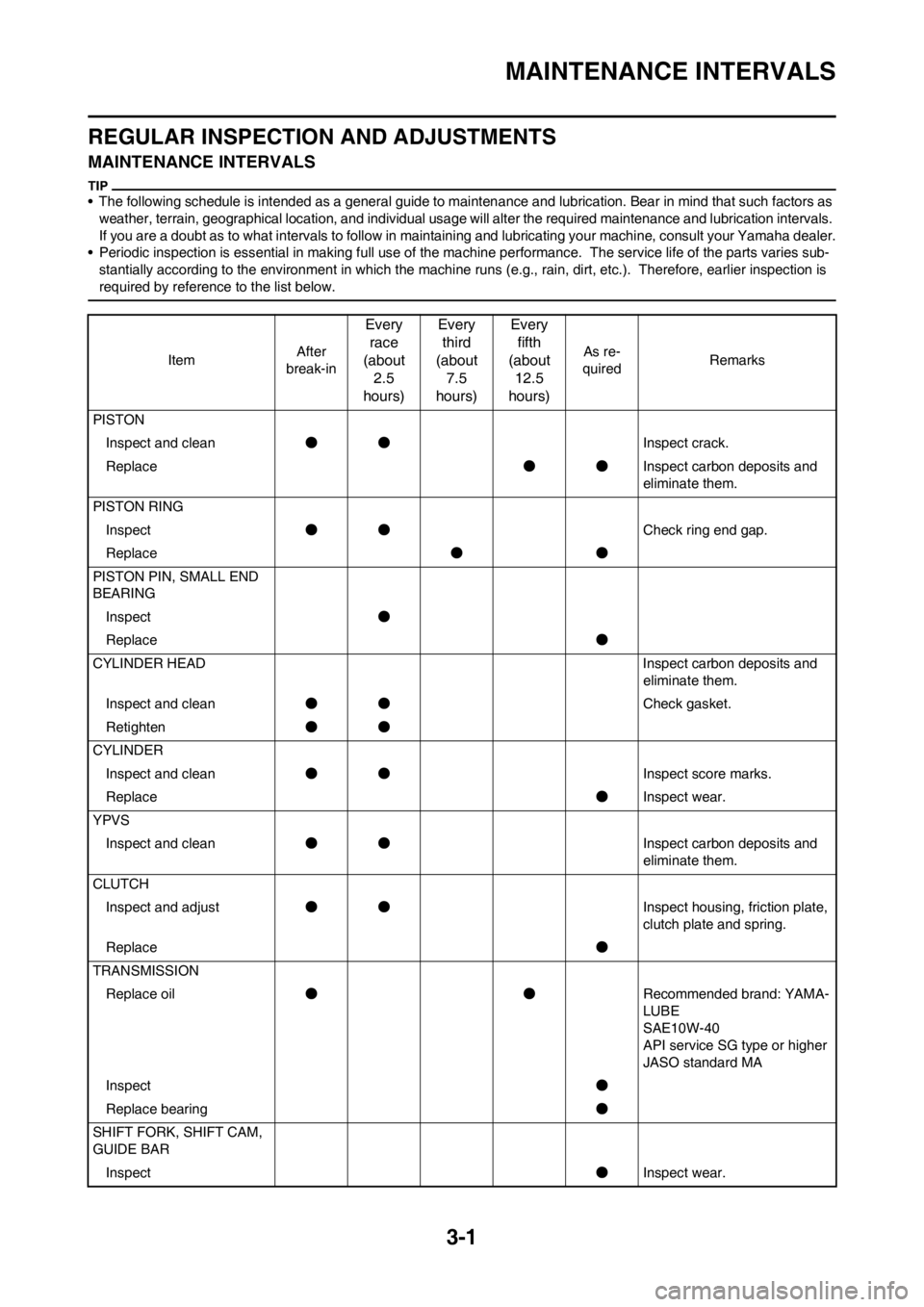
3-1
MAINTENANCE INTERVALS
REGULAR INSPECTION AND ADJUSTMENTS
MAINTENANCE INTERVALS
• The following schedule is intended as a general guide to maintenance and lubrication. Bear in mind that such factors as
weather, terrain, geographical location, and individual usage will alter the required maintenance and lubrication intervals.
If you are a doubt as to what intervals to follow in maintaining and lubricating your machine, consult your Yamaha dealer.
• Periodic inspection is essential in making full use of the machine performance. The service life of the parts varies sub-
stantially according to the environment in which the machine runs (e.g., rain, dirt, etc.). Therefore, earlier inspection is
required by reference to the list below.
ItemAfter
break-in
Every
race
(about
2.5
hours)Every
third
(about
7.5
hours)Every
fifth
(about
12.5
hours)
As re-
quiredRemarks
PISTON
Inspect and clean●●Inspect crack.
Replace●●Inspect carbon deposits and
eliminate them.
PISTON RING
Inspect●●Check ring end gap.
Replace●●
PISTON PIN, SMALL END
BEARING
Inspect●
Replace●
CYLINDER HEAD Inspect carbon deposits and
eliminate them.
Inspect and clean●●Check gasket.
Retighten●●
CYLINDER
Inspect and clean●●Inspect score marks.
Replace●Inspect wear.
YPVS
Inspect and clean●●Inspect carbon deposits and
eliminate them.
CLUTCH
Inspect and adjust●●Inspect housing, friction plate,
clutch plate and spring.
Replace●
TRANSMISSION
Replace oil●●Recommended brand: YAMA-
LUBE
SAE10W-40
API service SG type or higher
JASO standard MA
Inspect●
Replace bearing●
SHIFT FORK, SHIFT CAM,
GUIDE BAR
Inspect●Inspect wear.
Page 48 of 168

3-5
PRE-OPERATION INSPECTION AND MAINTENANCE
PRE-OPERATION INSPECTION AND MAINTENANCE
Before riding for break-in operation, practice or a race, make sure the machine is in good operating condition.
Before using this machine, check the following points.
GENERAL INSPECTION AND MAINTENANCE
Item Routine Page
CoolantCheck that coolant is filled up to the radiator cap. Check the cool-
ing system for leakage.P.3-6 – 7
FuelCheck that a fresh mixture of oil and gasoline is filled in the fuel
tank. Check the fuel line for leakage.P.1-12
Transmission oilCheck that the oil level is correct. Check the crankcase for leak-
age.P.3-8 – 9
Gear shifter and clutchCheck that gears can be shifted correctly in order and that the
clutch operates smoothly.P.3-7
Throttle grip/HousingCheck that the throttle grip operation and free play are correctly
adjusted. Lubricate the throttle grip and housing, if necessary.P.3-7 – 8
Brakes Check the play of front brake and effect of front and rear brake. P.3-9 – 12
Drive chainCheck drive chain slack and alignment. Check that the drive chain
is lubricated properly.P.3-12 – 13
WheelsCheck for excessive wear and tire pressure. Check for loose
spokes and have no excessive play.P.3-16 – 17
SteeringCheck that the handlebar can be turned smoothly and have no ex-
cessive play.P.3-17
Front forks and rear shock
absorberCheck that they operate smoothly and there is no oil leakage.
P.3-13 – 16
Cables (wires)Check that the clutch and throttle cables move smoothly. Check
that they are not caught when the handlebars are turned or when
the front forks travel up and down.—
Muffler Check that the muffler is tightly mounted and has no cracks. P.4-3 – 4
Rear wheel sprocket Check that the rear wheel sprocket tightening bolt is not loose. P.3-12
Lubrication Check for smooth operation. Lubricate if necessary. P.3-18
Bolts and nuts Check the chassis and engine for loose bolts and nuts. P.1-13
Lead connectorsCheck that the CDI magneto, CDI unit, and ignition coil are con-
nected tightly.P.1-7
SettingsIs the machine set suitably for the condition of the racing course
and weather or by taking into account the results of test runs be-
fore racing? Are inspection and maintenance completely done?P.7-1 – 11
Page 51 of 168
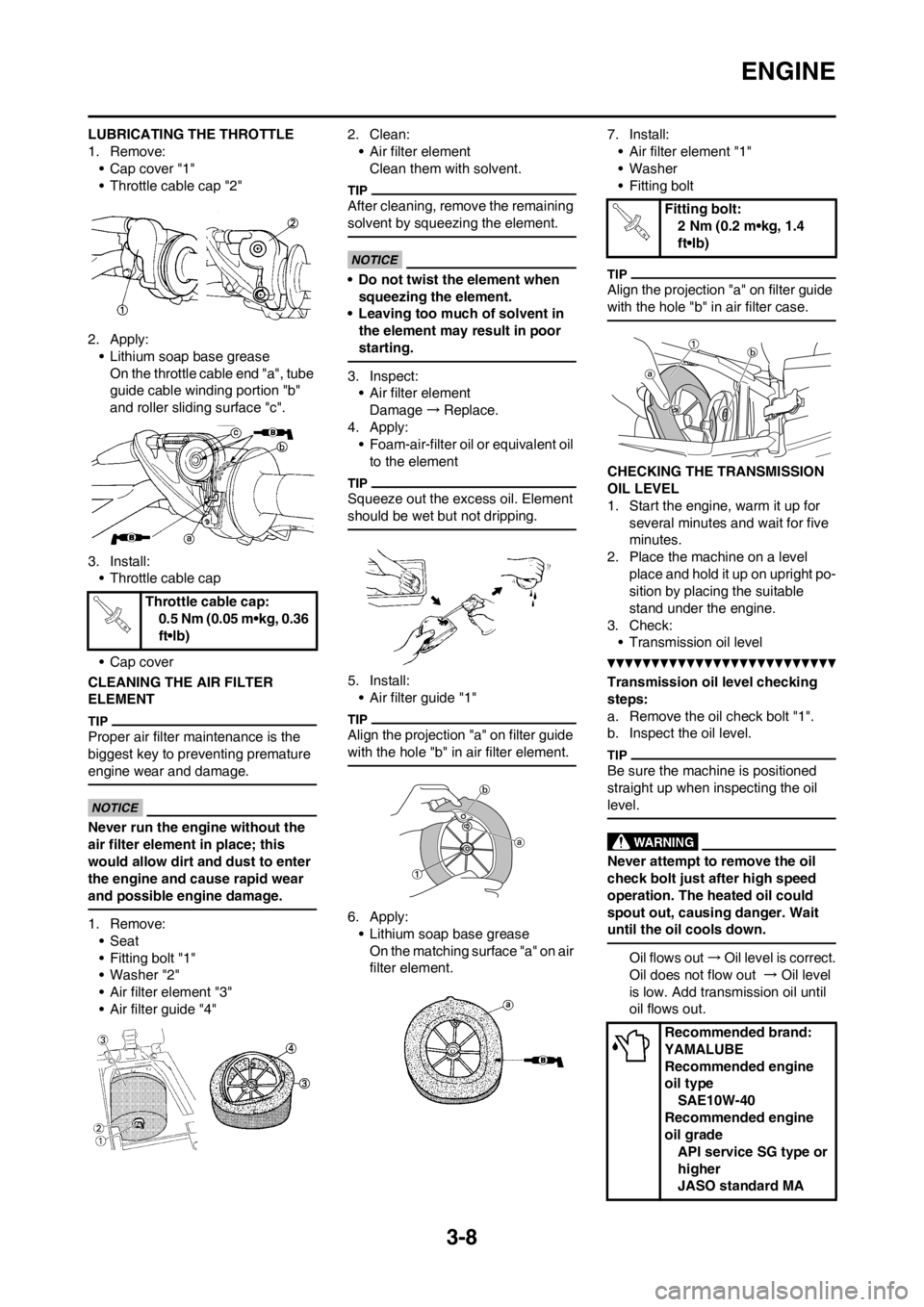
3-8
ENGINE
LUBRICATING THE THROTTLE
1. Remove:
• Cap cover "1"
• Throttle cable cap "2"
2. Apply:
• Lithium soap base grease
On the throttle cable end "a", tube
guide cable winding portion "b"
and roller sliding surface "c".
3. Install:
• Throttle cable cap
• Cap cover
CLEANING THE AIR FILTER
ELEMENT
Proper air filter maintenance is the
biggest key to preventing premature
engine wear and damage.
Never run the engine without the
air filter element in place; this
would allow dirt and dust to enter
the engine and cause rapid wear
and possible engine damage.
1. Remove:
• Seat
• Fitting bolt "1"
• Washer "2"
• Air filter element "3"
• Air filter guide "4"2. Clean:
• Air filter element
Clean them with solvent.
After cleaning, remove the remaining
solvent by squeezing the element.
• Do not twist the element when
squeezing the element.
• Leaving too much of solvent in
the element may result in poor
starting.
3. Inspect:
• Air filter element
Damage →Replace.
4. Apply:
• Foam-air-filter oil or equivalent oil
to the element
Squeeze out the excess oil. Element
should be wet but not dripping.
5. Install:
• Air filter guide "1"
Align the projection "a" on filter guide
with the hole "b" in air filter element.
6. Apply:
• Lithium soap base grease
On the matching surface "a" on air
filter element.7. Install:
• Air filter element "1"
• Washer
• Fitting bolt
Align the projection "a" on filter guide
with the hole "b" in air filter case.
CHECKING THE TRANSMISSION
OIL LEVEL
1. Start the engine, warm it up for
several minutes and wait for five
minutes.
2. Place the machine on a level
place and hold it up on upright po-
sition by placing the suitable
stand under the engine.
3. Check:
• Transmission oil level
Transmission oil level checking
steps:
a. Remove the oil check bolt "1".
b. Inspect the oil level.
Be sure the machine is positioned
straight up when inspecting the oil
level.
Never attempt to remove the oil
check bolt just after high speed
operation. The heated oil could
spout out, causing danger. Wait
until the oil cools down.
Oil flows out → Oil level is correct.
Oil does not flow out → Oil level
is low. Add transmission oil until
oil flows out. Throttle cable cap:
0.5 Nm (0.05 m•kg, 0.36
ft•lb)
Fitting bolt:
2 Nm (0.2 m•kg, 1.4
ft•lb)
Recommended brand:
YAMALUBE
Recommended engine
oil type
SAE10W-40
Recommended engine
oil grade
API service SG type or
higher
JASO standard MA
Page 52 of 168
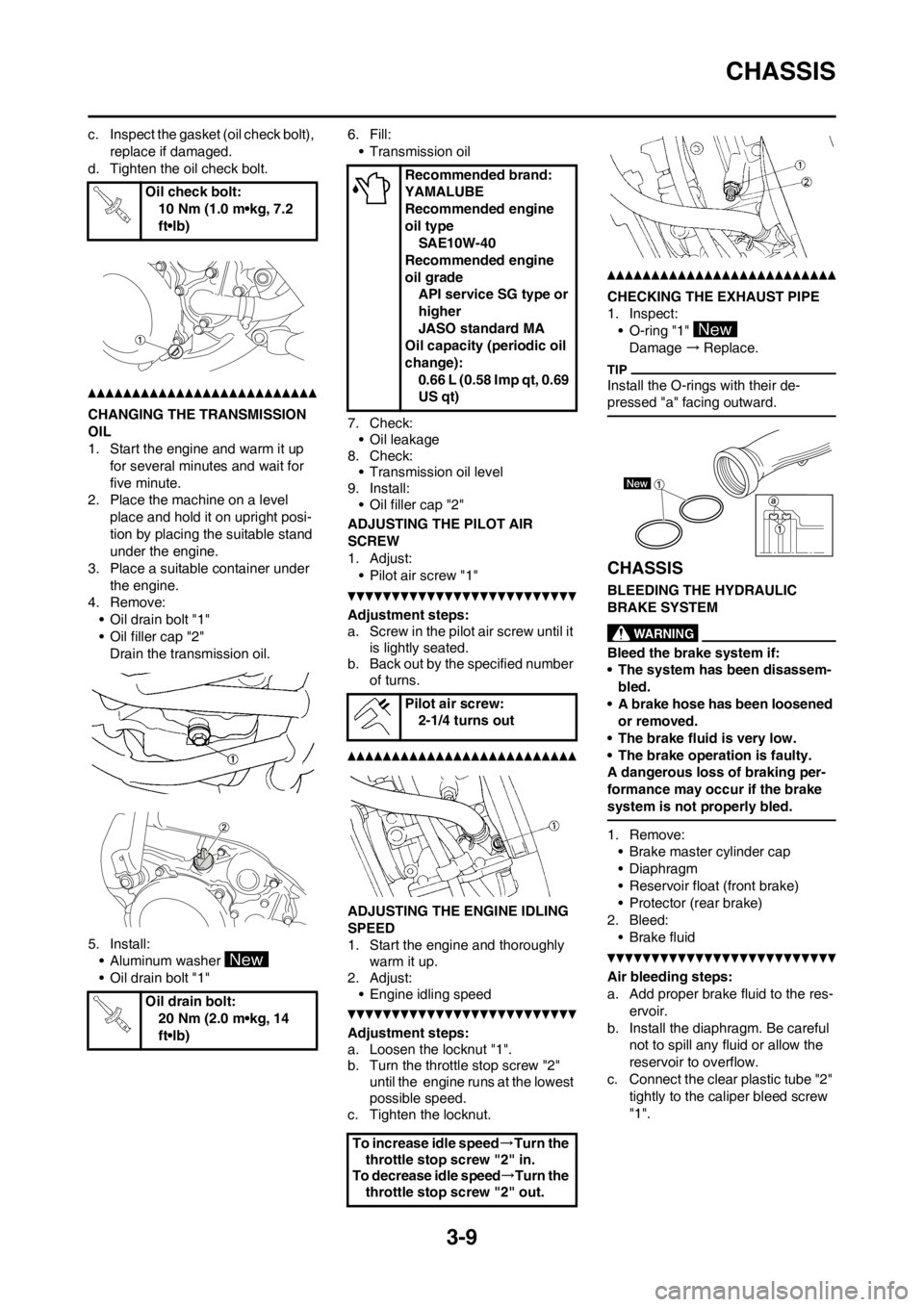
3-9
CHASSIS
c. Inspect the gasket (oil check bolt),
replace if damaged.
d. Tighten the oil check bolt.
CHANGING THE TRANSMISSION
OIL
1. Start the engine and warm it up
for several minutes and wait for
five minute.
2. Place the machine on a level
place and hold it on upright posi-
tion by placing the suitable stand
under the engine.
3. Place a suitable container under
the engine.
4. Remove:
• Oil drain bolt "1"
• Oil filler cap "2"
Drain the transmission oil.
5. Install:
• Aluminum washer
• Oil drain bolt "1"6. Fill:
• Transmission oil
7. Check:
• Oil leakage
8. Check:
• Transmission oil level
9. Install:
• Oil filler cap "2"
ADJUSTING THE PILOT AIR
SCREW
1. Adjust:
• Pilot air screw "1"
Adjustment steps:
a. Screw in the pilot air screw until it
is lightly seated.
b. Back out by the specified number
of turns.
ADJUSTING THE ENGINE IDLING
SPEED
1. Start the engine and thoroughly
warm it up.
2. Adjust:
• Engine idling speed
Adjustment steps:
a. Loosen the locknut "1".
b. Turn the throttle stop screw "2"
until the engine runs at the lowest
possible speed.
c. Tighten the locknut.
CHECKING THE EXHAUST PIPE
1. Inspect:
• O-ring "1"
Damage →Replace.
Install the O-rings with their de-
pressed "a" facing outward.
CHASSIS
BLEEDING THE HYDRAULIC
BRAKE SYSTEM
Bleed the brake system if:
• The system has been disassem-
bled.
• A brake hose has been loosened
or removed.
• The brake fluid is very low.
• The brake operation is faulty.
A dangerous loss of braking per-
formance may occur if the brake
system is not properly bled.
1. Remove:
• Brake master cylinder cap
• Diaphragm
• Reservoir float (front brake)
• Protector (rear brake)
2. Bleed:
• Brake fluid
Air bleeding steps:
a. Add proper brake fluid to the res-
ervoir.
b. Install the diaphragm. Be careful
not to spill any fluid or allow the
reservoir to overflow.
c. Connect the clear plastic tube "2"
tightly to the caliper bleed screw
"1". Oil check bolt:
10 Nm (1.0 m•kg, 7.2
ft•lb)
Oil drain bolt:
20 Nm (2.0 m•kg, 14
ft•lb)
Recommended brand:
YAMALUBE
Recommended engine
oil type
SAE10W-40
Recommended engine
oil grade
API service SG type or
higher
JASO standard MA
Oil capacity (periodic oil
change):
0.66 L (0.58 Imp qt, 0.69
US qt)
Pilot air screw:
2-1/4 turns out
To increase idle speed→Turn the
throttle stop screw "2" in.
To decrease idle speed→Turn the
throttle stop screw "2" out.